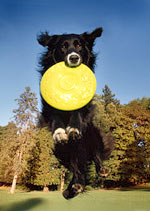|
Need Help? |
|
Call
1-800-372-3706
to
speak to a Veterinary Behavior Technician |
|
Paws for Help!
|
|

Click on Library Icon |
|
Help is at your
fingertips
by
library, email
and phone! |

Helpful Links
Sit to Say Please
|
|
Dog Behavior Library
|
Dog
Excitable Personality
Why
is my dog so hyper?
This is
a common question with many
possible answers. Consider which
of these factors might at least
partly account for your dog's
behavior:
|
Fortunately,
you can bring this problem
under control no matter
which factors account for
it. |
- Some
species have been bred for
a high energy level –
to herd sheep, for example,
or
to lead hunters to game. This
genetic component could be
powerful, depending on what
kind of dog you have.

- Since
they've been people's
companions for centuries,
all dogs may have a genetic
drive toward attention-seeking
behavior.
- Many
dogs need more exercise than
they're getting.
- Some
owners don't realize
that generally a dog will
be unruly unless he's
deliberately and consistently
taught manners.
- Owners
often give lots of attention
when their dogs misbehave
(encouraging what they don't
want) and virtually ignore
them when they're calm
(punishing the dog for good
manners).
- Like
children, dogs can have attention
deficit disorder (ADD), which
most researchers today believe
is a neurological condition
that results from a physical
inability to regulate levels
of neurotransmitters (substances
that transmit signals in the
brain).
-
Several types of anxiety can
contribute to hyperactivity.
"Punishment anxiety"
may result if a dog is disciplined
without understanding the
reason. "Leadership
anxiety" indicates the
dog is uncertain of his place
in the hierarchy of household
dogs or unclear about whether
his owner is in charge. Often
dogs who get overexcited when
greeting their owners are
suffering some separation
anxiety, much like children
who fear their parents won't
return for them.
Suggestions
Fortunately,
you can bring this problem under
control no matter which factors
account for it. What's
crucial in your basic approach
is to respond calmly and in
the same way each time your
dog acts up. In addition, consider
these measures.
-
If your dog is male and hasn't
been neutered, have this surgery
done. It won't resolve
the problem by itself, but
neutered dogs are usually
less frenetic.
- Increase
the amount of exercise your
dog gets. Unless you have
a huge yard, you'll
probably need to take him
out for walks (or runs) or
to a park where you can romp
or play fetch together. If
he's high-strung, providing
chew toys is also a good idea.
-
Don't give your dog
attention when he's
hyper. Leave the room and
close the door. Also, remember
to praise him and show affection
when he's relaxed.
- Don't
reprimand your dog for any
misbehavior that occurred
more than a few seconds earlier.
He won't understand
the connection.
- Learn
more about training your dog
– with a good book,
video, or obedience course
– and practice good
manners with him every day.
He's depending on you
to show him how you want him
to behave.
- To
deter undesirable behavior,
get a head halter for your
dog. (This effective restraint
allows the owner to exert
pressure behind the dog's
neck and around the muzzle.)
Use it on walks, checking
him for pulling ahead or any
unruly conduct.
- Establish
yourself as your dog's
leader: Have him earn dinner,
treats, petting, and praise
by performing Instructions; for
instance, give him his supper
only after he sits for a few
seconds. Teach him to wait
and let you go first through
doors. If your dog has a bossy
personality, don't let
him sleep on your bed or other
furniture; give him a spot
at the foot of your bed.
- Through
the "close-tether training
technique," you can
teach your dog to accept –
and even enjoy – being
tied up for short periods.
Use a two- to three-foot leash.
If your dog is independent,
you can encourage bonding
by practicing this technique
at home; keep him tied near
you or to your ankle or belt.
If your dog is aggressive
or doesn't know that
you're his leader, tether
him away from you for a 10-
to 20-minute time-out. If
he gets anxious when you leave,
wait for him to be calm and
then leave for gradually longer
periods, always returning
before he shows distress;
to desensitize him, ignore
him when you leave and come
back.
- If
you patiently practice these
measures for weeks and see
little improvement, consult
your veterinarian. To test
for attention deficit disorder,
your dog may be given a stimulant
such as dextroamphetamine
(also used for children with
ADD). If the test is positive
(he settles down), he may
be put on a daily dose for
life.
|
|
|